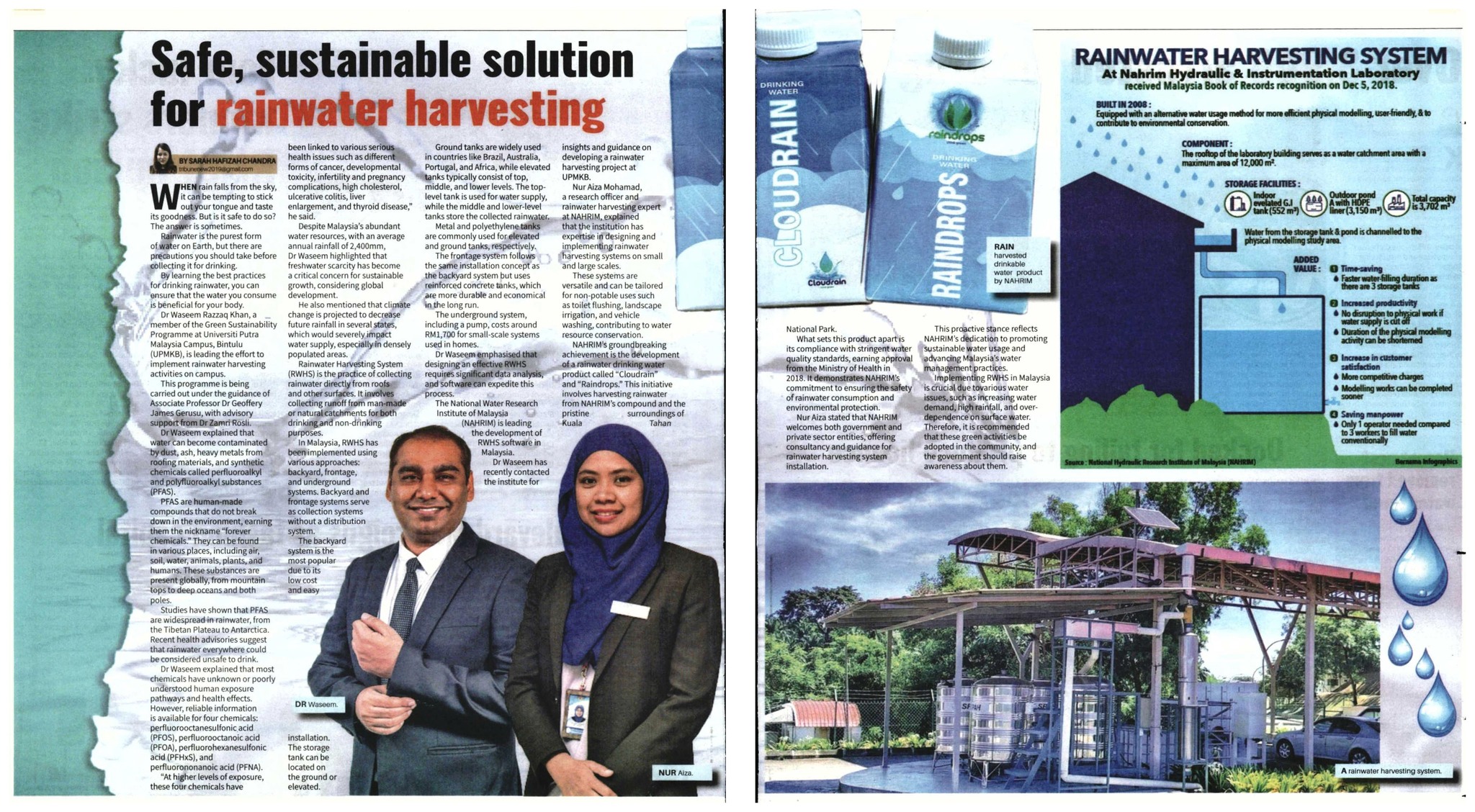When rain falls from the sky, it can be tempting to stick out your tongue and taste its goodness. But is it safe to do so? The answer is sometimes. Rainwater is the purest form of water on Earth, but there are precautions you should take before collecting it for drinking.
By learning the best practices for drinking rainwater, you can ensure that the water you consume is beneficial for your body. Dr Waseem Razzaq Khan, a member of the Green Sustainability Programme at Universiti Putra Malaysia Campus, Bintulu (UPMKB), is leading the effort to implement rainwater harvesting activities on campus.
This programme is being carried out under the guidance of Associate Professor Dr Geoffery James Gerusu, with advisory support from Dr Zamri Rosli. Waseem explained that water can become contaminated by dust, ash, heavy metals from roofing materials, and synthetic chemicals called perfluoroalkyl and polyfluoroalkyl substances (PFAS).
PFAS are human-made compounds that do not break down in the environment, earning them the nickname “forever chemicals.” They can be found in various places, including air, soil, water, animals, plants, and humans. These substances are present globally, from mountain tops to deep oceans and both poles.
Studies have shown that PFAS are widespread in rainwater, from the Tibetan Plateau to Antarctica. Recent health advisories suggest that rainwater everywhere could be considered unsafe to drink.
Waseem explained that most chemicals have unknown or poorly understood human exposure pathways and health effects. However, reliable information is available for four chemicals: perfluorooctanesulfonic acid (PFOS), perfluorooctanoic acid (PFOA), perfluorohexanesulfonic acid (PFHxS), and perfluorononanoic acid (PFNA).
“At higher levels of exposure, these four chemicals have been linked to various serious health issues such as different forms of cancer, developmental toxicity, infertility and pregnancy complications, high cholesterol, ulcerative colitis, liver enlargement, and thyroid disease,” he said.
Despite Malaysia’s abundant water resources, with an average annual rainfall of 2,400mm, Waseem highlighted that freshwater scarcity has become a critical concern for sustainable growth, considering global development.
He also mentioned that climate change is projected to decrease future rainfall in several states, which would severely impact water supply, especially in densely populated areas.
Rainwater Harvesting System (RWHS) is the practice of collecting rainwater directly from roofs and other surfaces. It involves collecting runoff from man-made or natural catchments for both drinking and non-drinking purposes.
In Malaysia, RWHS has been implemented using various approaches: backyard, frontage, and underground systems. Backyard and frontage systems serve as collection systems without a distribution system.
The backyard system is the most popular due to its low cost and easy installation. The storage tank can be located on the ground or elevated. Ground tanks are widely used in countries like Brazil, Australia, Portugal, and Africa, while elevated tanks typically consist of top, middle, and lower levels. The top-level tank is used for water supply, while the middle and lower-level tanks store the collected rainwater.
Metal and polyethylene tanks are commonly used for elevated and ground tanks, respectively. The frontage system follows the same installation concept as the backyard system but uses reinforced concrete tanks, which are more durable and economical in the long run.
The underground system, including a pump, costs around RM1,700 for small-scale systems used in homes. Waseem emphasised that designing an effective RWHS requires significant data analysis, and software can expedite this process.
The National Water Research Institute of Malaysia (NAHRIM) is leading the development of RWHS software in Malaysia. Waseem has recently contacted the institute for insights and guidance on developing a rainwater harvesting project at UPMKB.
Nur Aiza Mohamad, a research officer and rainwater harvesting expert at NAHRIM, explained that the institution has expertise in designing and implementing rainwater harvesting systems on small and large scales.
These systems are versatile and can be tailored for non-potable uses such as toilet flushing, landscape irrigation, and vehicle washing, contributing to water resource conservation.
NAHRIM’s groundbreaking achievement is the development of a rainwater drinking water product called “Cloudrain” and “Raindrops.” This initiative involves harvesting rainwater from NAHRIM’s compound and the pristine surroundings of Kuala Tahan National Park.
What sets this product apart is its compliance with stringent water quality standards, earning approval from the Ministry of Health in 2018. It demonstrates NAHRIM’s commitment to ensuring the safety of rainwater consumption and environmental protection.
Nur Aiza stated that NAHRIM welcomes both government and private sector entities, offering consultancy and guidance for rainwater harvesting system installation. This proactive stance reflects NAHRIM’s dedication to promoting sustainable water usage and advancing Malaysia’s water management practices.
Implementing RWHS in Malaysia is crucial due tovarious water issues, such as increasing water demand, high rainfall, and over-dependence on surface water. Therefore, it is recommended that these green activities be adopted in the community, and the government should raise awareness about them.

Tarikh Input: 24/10/2023 | Kemaskini: 24/10/2023 | lanz
PERKONGSIAN MEDIA
































